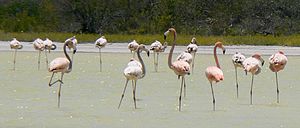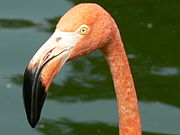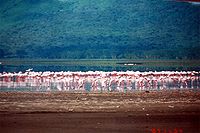
Flamingo
Background Information
This wikipedia selection has been chosen by volunteers helping SOS Children from Wikipedia for this Wikipedia Selection for schools. To compare sponsorship charities this is the best sponsorship link.
| Flamingo Temporal range: Eocene - Recent |
|
|---|---|
 |
|
| An American Flamingo (Phoenicopterus ruber), with Chilean Flamingos (P. chilensis) in the background | |
| Scientific classification | |
| Kingdom: | Animalia |
| Phylum: | Chordata |
| Class: | Aves |
| Infraclass: | Neognathae |
| Order: | Phoenicopteriformes Fürbringer, 1888 |
| Family: | Phoenicopteridae Bonaparte, 1831 |
| Genus: | Phoenicopterus Linnaeus, 1758 |
| Species | |
|
See text |
|
Flamingos or flamingoes (pronunciation) are gregarious wading birds in the genus Phoenicopterus and family Phoenicopteridae. They are found in both the Western Hemisphere and Eastern Hemisphere, but are more numerous in the former. There are four species in the Americas while two exist in the Old World. Two species, the Andean and the James's Flamingo, are often placed in the genus Phoenicoparrus instead of Phoenicopterus.
Systematics
Species
| Species | Geographic location | |
|---|---|---|
| Greater Flamingo (P. roseus) | Old World | Parts of Africa, S. Europe and S. and SW Asia (most widespread flamingo). |
| Lesser Flamingo (P. minor) | Africa (e.g. Great Rift Valley) to NW India (most numerous flamingo). | |
| Chilean Flamingo (P. chilensis) | New World | Temperate S. South America. |
| James's Flamingo (P. jamesi) | High Andes in Peru, Chile, Bolivia and Argentina. | |
| Andean Flamingo (P. andinus) | High Andes in Peru, Chile, Bolivia and Argentina. | |
| American Flamingo (P. ruber) | Caribbean and Galapagos islands. | |
Evolution


The prehistory of the Phoenicopteriformes is far better researched than their systematic affinities (see below). An extinct family of peculiar "swimming flamingos", the Palaelodidae, was initially believed to be the ancestors of the Phoenicopteridae. This is now rejected, as the fossil genus Elornis, apparently a true albeit primitive flamingo, is known from the Late Eocene, before any palaelodid flamingoes have been recorded. A considerable number of little-known birds from the Late Cretaceous onwards are sometimes considered to be flamingo ancestors. These include the genera Torotix, Scaniornis, Gallornis, Agnopterus, Tiliornis, Juncitarsus and Kashinia; these show a mix of characters and are fairly plesiomorphic in comparison to modern birds. There exists a fairly comprehensive fossil record of the genus Phoenicopterus. The systematics of prehistoric Phoenicopteriformes known only from fossils is as followed:
- Palaelodidae
- Stout-legged Flamingo (Borgloon Early Oligocene of Hoogbutsel, Belgium)
- Palaelodus (Middle Oligocene -? Middle Pleistocene)
- Megapaloelodus (Late Oligocene - Early Pliocene)
- Phoenicopteridae
- Elornis (Middle? Eocene - Early Oligocene) - includes Actiornis
- Phoenicopteridae gen. et sp. indet. (Camacho Middle? - Late Miocene? of San José, Uruguay) - see Ubilla et al. (1990)
- Prehistoric species of Phoenicopterus:
- Phoenicopterus croizeti (Middle Oligocene - Middle Miocene of C Europe)
- Phoenicopterus floridanus (Early Pliocene of Florida)
- Phoenicopterus stocki (Middle Pliocene of Rincón, Mexico)
- Phoenicopterus copei (Late Pleistocene of W North America and C Mexico)
- Phoenicopterus minutus (Late Pleistocene of California, USA)
- Phoenicopterus aethiopicus
Relationships
The identity of the closest relatives of the flamingos is a rather contentious issue. Traditionally, the long-legged Ciconiiformes, probably a paraphyletic assemblage, have been considered the flamingos' closest relatives and the family was included in the order. Usually the spoonbills and ibises of the Threskiornithidae were considered their closest relatives within this order. Nevertheless, relationships to the Anseriformes (waterfowl) were considered as well (Sibley et al. 1969), especially as flamingos and waterfowl are parasitized by feather lice of the genus Anaticola (Johnson et al. 2006), which are otherwise exclusively found on ducks and geese.
To reflect the uncertainty about this matter, flamingos began to be placed in their own order later on. Other scientists proposed flamingos as waders most closely related to the stilts and avocets, Recurvirostridae. The peculiar presbyornithids were used to argue for a close relationship between flamingos, waterfowl, and waders (Feduccia 1976), but they are now known to be unequivocal waterfowl with a peculiarly derived morphology paralleling waders and flamingos.
In recent years, molecular and anatomical studies have yielded confusing results: Sibley & Monroe placed flamingos within their expanded (and certainly paraphyletic, as is now known) Ciconiiformes. On the other hand, since long it has been the grebes ( Podicipedidae), rather than Ciconiiformes, ducks, or stilts, that were time and again indicated as the closest relatives of flamingos, and there is currently renewed interest in this hypothesis.
In a 2004 study comparing DNA sequences of intron 7 of the β- fibrinogen gene (FGB-int7), the Neognathae (all living birds except the ratites and tinamous) excluding waterfowl and Galliformes were shown to be divided into two subgroups of uneven size. The first and smaller one, Metaves, contains flamingos and grebes, alongside the hoatzin, pigeons, sandgrouse, the Caprimulgiformes, the Apodiformes, tropicbirds, mesites, sunbittern and kagu. Interestingly, most of these groups have traditionally been difficult to place on the family tree of birds. According to this study, all other birds belong to the second subgroup of Neoaves, the Coronaves (Fain & Houde 2004).
But their molecular data was insufficient to resolve inter-Metaves relationships to satisfaction; the flamingo FGB-int7 sequence is apparently most similar to that of some species of nighthawks, strongly suggesting a case of convergent evolution on the molecular level. The conclusions that one can draw from this study are twofold: first, that flamingos are Metaves (if that group is not based on molecular convergence, for which there are some indications), and second, that FBG-int7 is unsuitable to determine their relationships beyond that. It is interesting to note, however, that among all the groups which have been proposed as sister taxa of the flamingos, only the grebes are Metaves. The relationships of the flamingos still cannot be resolved with any certainty, but presently a close relationship with grebes appears somewhat more likely than other proposals. For this clade, the taxon Mirandornithes ("miraculous birds" due to their extreme divergence and apomorphies) has been proposed. In summary, all this confusion serves to show that all lines of "evidence" - molecular, morphological, ecological and parasitological - are liable to yield erroneous "proof" and that no method can be considered generally superior. Any future attempt to finally resolve the flamingos' relationships, therefore, would have to employ total evidence to support it and carefully weigh the data against alternative proposals.
Description
Diet
Flamingos filter-feed on brine shrimp. Their oddly-shaped beaks are specially adapted to separate mud and silt from the food they eat, and are uniquely used upside-down. The filtering of food items is assisted by hairy structures called lamellae which line the mandibles, and the large rough-surfaced tongue. The flamingo's characteristic pink colouring is caused by the Beta carotene in their diet. The source of this varies by species, but shrimp and blue-green algae are common sources; zoo-fed flamingos may be given food with the additive canthaxanthin, which is often also given to farmed salmon. Flamingos produce a "milk" like pigeon milk due to the action of a hormone called prolactin (see Columbidae). It contains more fat and less protein than the latter does, and it is produced in glands lining the whole of the upper digestive tract, not just the crop. Both parents nurse their chick, and young flamingos feed on this milk, which also contains red and white blood cells, for about two months until their bills are developed enough to filter feed.
Appearance

Flamingos frequently stand on one leg. The reason for this behaviour is not fully known. One common theory is that tucking one leg beneath the body may conserve body heat, but this has not been proven. It is often suggested that this is done in part to keep the legs from getting wet, in addition to conserving energy. As well as standing in the water, flamingos may stamp their webbed feet in the mud to stir up food from the bottom.
Young flamingos hatch with grey plumage, but adults range from light pink to bright red due to aqueous bacteria and beta carotene obtained from their food supply. A well-fed, healthy flamingo is more vibrantly coloured and thus a more desirable mate. A white or pale flamingo, however, is usually unhealthy or malnourished. Captive flamingos are a notable exception; many turn a pale pink as they are not fed carotene at levels comparable to the wild. This is changing as more zoos begin to add prawns and other supplements to the diets of their flamingos.
Conservation status
Scientists have discovered that flamingos are dying by the thousands along the Rift Valley lakes of Kenya and Tanzania. However, they are baffled about the reason. Possible causes include avian cholera, botulism, metal pollution, pesticides or poisonous bacteria, say researchers. Also, fears for the future of the Lesser Flamingo — Phoeniconaias minor — have also been raised by plans to pipe water from one of their key breeding areas, the shores of Lake Natron. The lakes are crucial to the birds' breeding success because the flamingos feed off the blooms of cyanobacteria that thrive there.
Most scientific attention has focused on the environmental changes to the lakes. Water levels have lowered and concentrations of salt in the water have increased. This increases the risk of toxic bacteria growing there.
Culinary use
In Ancient Rome, flamingo tongues were considered a delicacy. Also, Andean miners have killed flamingos for their fat, believed to be a cure for tuberculosis.






